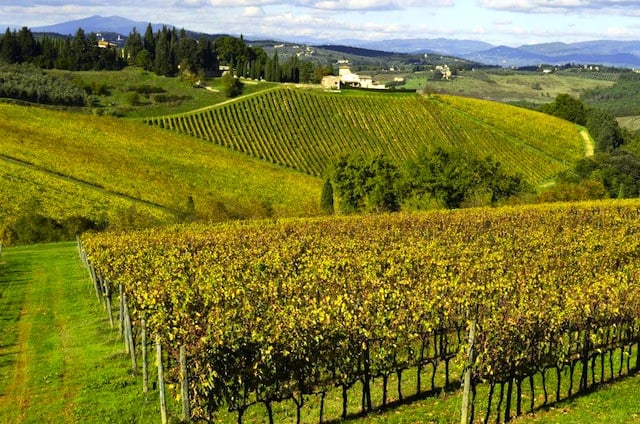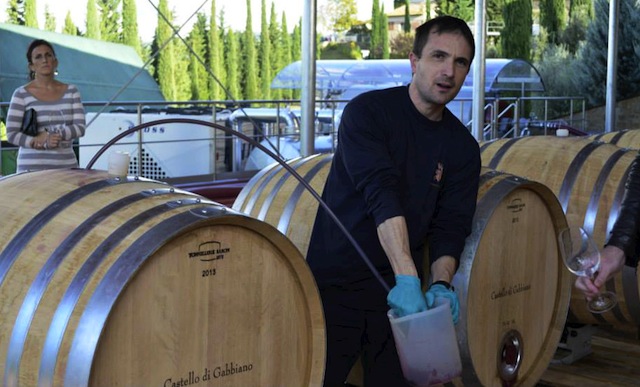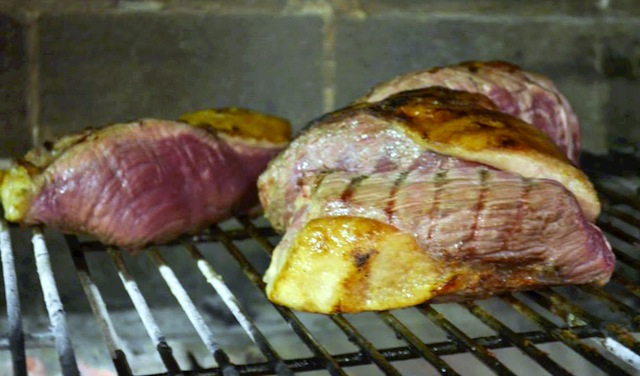Photo Guide: A Delicious And Tipsy Journey Through Tuscany
Note: My trip to Tuscany was sponsored by Castello di Gabbiano. I was not required to write this post nor was I compensated. All opinions are my own.
Recently, I was given the opportunity to stay at two excellent properties in Tuscany: Castello di Gabbiano and Castelfalfi.
Both hold rich histories, castle experiences, scenic outdoor experiences, and, my favorite facet of the region, traditional Tuscan dishes made with fresh, local ingredients, fresh-pressed olive oil, white truffle and cherry-accented Sangiovese.
This is the part of Tuscany I immersed myself in during my week-long binge of epicurious culture: taking cooking classes, touring olive mills, vineyard excursions, barrel tasting, wine pairing, and gorging myself on Pappa al Pomodoro, Pepposo di Manzo, and Cantucci Biscuits.
In my opinion, culinary stories are best told through photos, where they can be savored with the eyes and mind.
Continue reading for a visual Italy travel guide sharing details of my delicious trip. You’ll really see the many great things to do in Tuscany!
Castello di Gabbiano near Florence, Italy, allowed me to stay in a 12th-century castle, once home to wealthy Florentine families. The tower is the oldest part of the property, built to defend an important communication route between the constantly fighting Florence and Siena. Here, history gets mixed with farm culture, as the property is also an agritourism offering a number of experiences like food and wine pairing, vineyard touring, cooking classes, truffle hunting, olive pressing, vertical tastings, barrel tastings, blind tastings and more.
Wine is an important part of Tuscany culture, and the industry is strictly regulated by the government to ensure high-quality product and to preserve the landscape. There are three approved quality labels for Tuscan wines: DOCG, DOC and IGT. One of the most prevalent grapes you’ll find in Tuscany is Sangiovese, known for imparting flavors of cherry and cinnamon with an herbal quality. One fun way to experience great Sangiovese is to visit the Chianti Classico region and drive the Chianto Classico Road (Road 222). While you can drive straight through in less than two hours, it’s recommended to take your time and make stops at the different wineries and farms for wine tasting and olive pressing, as well as agritourismos for an overnight stay.
Visiting an agritourismo in Tuscany immerses you in the region’s farm culture, and also offers unique experiences. At Castello di Gabbiano, I was able to do a barrel tasting, sampling wine straight from the barrel instead of the bottle. These wines are unfinished, and typically have a very tart flavor. That being said, it’s an interesting way to learn about the wine-making process, why the winemaker picks certain grapes when he does, and how the barrel influences the finished product.
The above photo is of a meal I enjoyed at Castello di Gabbiano, a fresh egg tagliatelle topped with the highly-prized local white truffle. If you do only one thing when visiting Tuscany — especially if visiting during fall truffle season — try truffle. While you can order it at many restaurants, many agritourismos like Castello di Gabbino and Castelfalfi offer truffle hunting excursions. Here you’ll be able to go out with the farmer and their truffle-hunting dog in the wee hours of the night to see their secret forest spot for finding this delicious underground fungus. White truffle is the world’s most expensive fungus, at about $3,000 to $5,000 per pound or $7 to $11 per gram.
In Tuscany, cheese is an important part of the culinary culture. While you’ll be able to sample a variety of Italian cheeses — Caprino, Raviggiolo, Ricotta, Caciotta — the most important cheese in Tuscany is Pecorino. Made from sheep’s milk, how complex a Pecorino’s flavor is depends on its age. An older Pecorino will be more intricate, while a young one will have a delicate quality. There are a variety of Pecorino cheeses one can sample in Tuscany, some of which include Baccellone, Fossa, Casentino and Pienza.
Visit a working dairy farm — like Little Dairy La Stalletta or Cretaiole — for the full Tuscan cheese experience. There are a variety of tours offered (a Google search will pull up many) that visit Tuscan dairy farms and often combine this with wine, olive oil and/or truffle experiences. You can also visit a cheese shop like Remo Monaci in Pienza (Via Enzo Mangiavacchi, 25) — known for its impressive Pecorino selection and honey pairings — to sample different varieties for free before deciding to make (or not make) a purchase.
If one had to choose the most important ingredient in Tuscan cooking, it would undoubtedly be olive oil. Some of the world’s most high-quality olive oil comes from Tuscany, and locals use it for both cooking and dressing their dishes. While there are many misconceptions that exist about olive oil, one fact I found most interesting was extra virgin olive oil is not the highest quality. It’s actually premium olive oil, which is pressed immediately after picking. Although olives do have vintages like wine, they do not get better with age in terms of both taste and health benefits.
An interesting way to learn about Tuscany’s olive oil culture is by seeing how locals pick the olives — either by shaking the branches with a stick and having them fall to the ground onto a net or by using a machine that fervently shakes the trees and catches the falling olives in a giant scoop. From there, you can visit a mill and see how the olives are pressed into oil. Interestingly, only 10% of each olive gets made into oil, with the other 90% being waste that’s often used for fertilizer.
Tuscan cuisine features simple dishes created from fresh, local and natural ingredients with rich flavors that speak for themselves. Taking a cooking class in Tuscany is an excellent way to learn firsthand how locals make such scrumptious meals. In the above photo, I’m adding red wine to a traditional dish called Peposo di Manzo, which features chunks of beef muscle that have been marinated overnight in red wine, juniper berries, rosemary, sage, bay leafs and ground pepper. The next day, celery, onion, carrot and garlic are sauteed in olive oil and added to the mix, along with more wine, black pepper, salt, tomato peel, tomato, concentrate, cinnamon and nutmeg. It’s a hearty dish that has earthy yet sweet qualities.
During my visit to Tuscany I took two cooking classes, one at Castello di Gabbiano focusing on cooking with olive oil and one at Castelfalfi centered around traditional Tuscan cooking. Both are highly recommended.
Another reason to take a cooking class in Tuscany is to learn the art of handmade pasta, which is much simpler than I expected. Although certain varieties of pasta require the aid of a kitchen machine, not all do. During my olive oil cooking class with Castello di Gabbiano, I hand-made cavatelli pasta, which involves mixing semolina (instead of white flour) in very hot water with a little salt, waiting for it to cool a bit, and kneading it into a dough. Once the dough is smooth you cut sections about the length of three fingers and the width of one, press down with your middle three fingers and roll the dough toward you to make a pea-pod shape. From there, boil, dress and serve. It just take a few ingredients and a little upper arm strength and you can make a truly delicious Tuscan meal.
Another reason to take a cooking class in Tuscany is to understand the culinary philosophy. One interesting facet of many Tuscan dishes is they’re rooted in peasant cooking, meaning nothing goes to waste and what’s local, available and affordable is used. The above dish — called Pappa al Pomodoro, which I made during a class at Castelfalfi — is a great example of this, as it makes use of stale bread. It’s cooked in a mixture of fried onion, pepper, tomatoes and basil to create a filling, satisfying dish, and is one of the oldest traditions in Tuscany. It really shows how inventive the people of the countryside could be when it came to food, regardless of their income.
And don’t forget dessert! Cantucci Biscuits are an important Tuscan tradition, dating back to at least the 16th century when Roman soldiers ate a savory version of the treat during military campaigns. The sweet version appeared around the 14th century, when a “sugar boom” swept across North Africa and Southern Europe. Today, they’re typically paired with Tuscan Vin Santo, a sweet white wine great for dipping the crunchy biscuits. It’s the adult version of cookies and milk.
And to make it clear just how important olive oil is in Tuscan cooking, Olive Oil Cake is an important tradition I learned about during Castello di Gabbiano’s olive oil-focused cooking class. In Tuscany, olive oil isn’t just used for frying vegetables and to dress salads, but also in dessert. Don’t leave Tuscany without trying — or better yet, learning to cook for yourself — Olive Oil Cake, which is light and fluffy with notes of citrus.
Castello di Gabbiano offers a number of interesting wine tasting experiences: wine and meal pairing, barrel tastings, structured tastings, vineyard tours, blind tastings and, the one I will talk about now, vertical tastings. A vertical tasting refers to taking the same varietal from the same producer and sampling it from a number of consecutive vintages. For example, if you’re trying the Castello di Gabbiano Chianti Classico Riserva DOCG, you might taste a 2006, 2007, 2008, 2009, 2010 and 2011 to see how it’s changed from vintage to vintage, with the winemaker telling you why these changes occurred. It really shows how weather can dramatically change the characteristics a grape imparts on a wine.
Tuscany isn’t just a place to eat and drink, but also to get active in the outdoors. While adrenaline junkies may find the region’s rolling hills too tame, those who enjoy soft adventures in a scenic setting can partake in hiking, cycling and bird-watching. There are trails littered throughout Tuscany, providing great opportunities for photos and fresh air for both groups and those traveling solo in Italy.
Unique dining experiences are also part of a trip to Tuscany. During my trip there were four restaurants in particular that really stood out. The first is L’Officina della Bistecca in Panzano (Via XX Lugio 11) a carnivore’s delight. After enjoying a free aperitivo in the downstairs butcher shop — complete with red wine and savory snacks — head upstairs for a €50-Euro (about $67-USD) set menu of five different cuts of meat, baked potato, raw vegetables with olive oil, unlimited red wine, Grappa and Italian military spirits.
In Florence, Piazza del Vino (Via della Torretta, 8,) focuses on wines from all over Italy, with thousands of bottles to choose from. The ambient space features stone walls and wooden shelves showcasing the many varietals, and regulars have the option to purchase their own small wine cellar in the venue. The menu is also worth the visit, with dish’s showcasing the different regional specialties of the country.
Castello di Gabbiano’s Il Cavaliere is another must-try, located in a 16th-century farmhouse and offering views of the Tuscan countryside. Food focuses on typical Tuscan dishes with many ingredients sourced from their onsite spice and kitchen gardens. Servers pair food with Castello di Gabbiano’s own line of Chianti Classico wines.
And at Castelfalfi’s Il Rosmarino, you’ll be transported back in time with traditional dishes made by hand, with ingredients picked from the onsite farm or locally. It’s recommended to opt for a wine tasting with your meal, as Castelfalfi has its own line of wines, olive oils and vinegars.
What are your favorite things to do in Tuscany, Italy?

Hi, I’m Jessie on a journey!
I'm a conscious solo traveler on a mission to take you beyond the guidebook to inspire you to live your best life through travel. Come join me!

Want to live your best life through travel?
Subscribe for FREE access to my library of fun blogging worksheets and learn how to get paid to travel more!

















Speaking of world’s most expensive fungus, I recall a cheese festival being described as the world’s biggest mold enthusiast gathering. Kinda funny how gross it sounds when you put it that way, but how glorious it is in reality.
Choosing a cold-pressed olive oil can be similar to selecting a wine . The flavor of these oils varies considerably and a particular oil may be more suited for a particular dish. Also, people who like lots of tannins in their red wines might prefer more bitter olive oils.
@Jarrett: Great info. Thanks for sharing!